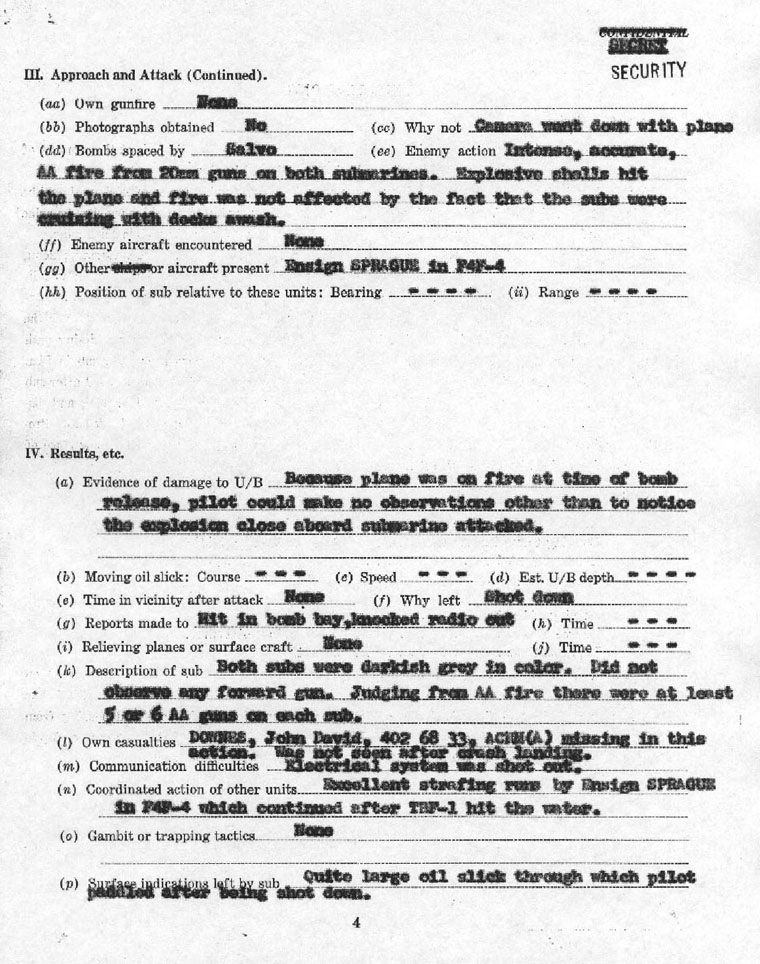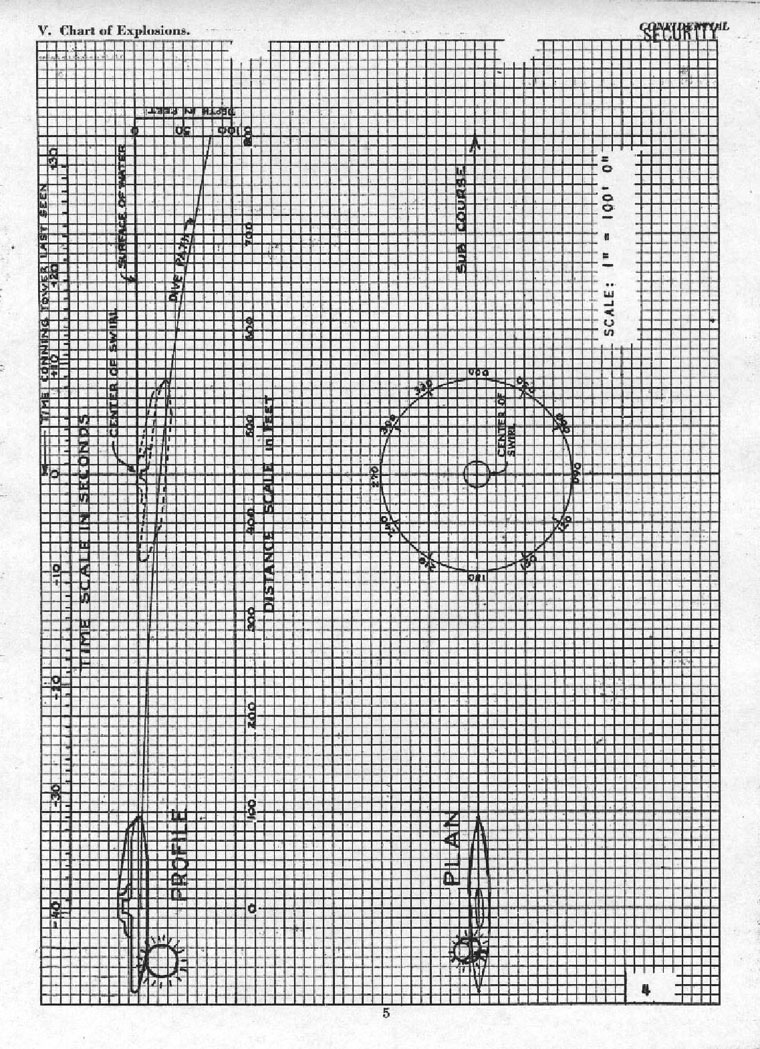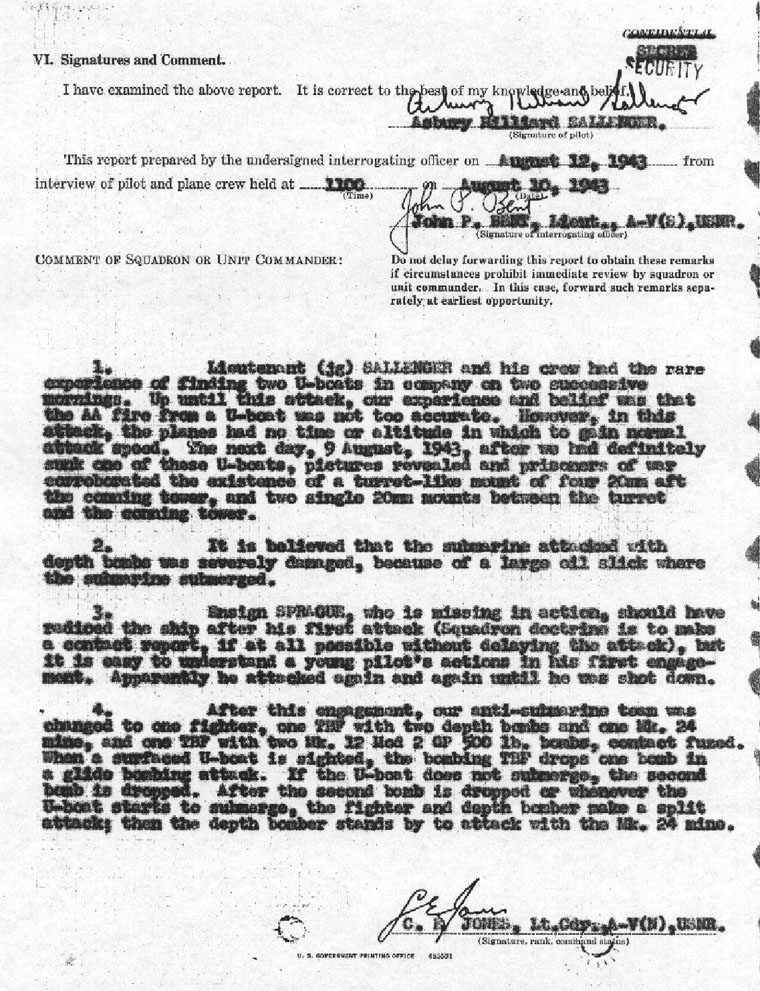COMPOSITE SQUADRON ONE |
|||||||||||||||||||||||
| File No. VC-1/A8 | |||||||||||||||||||||||
| Serial No. (21) c/o Fleet Post Office, | |||||||||||||||||||||||
| New York, New York. | |||||||||||||||||||||||
| 21 August 1943. | |||||||||||||||||||||||
| SECRET-SECURITY | |||||||||||||||||||||||
|
|||||||||||||||||||||||
| 1. Enclosure (A) is forwarded herewith. | |||||||||||||||||||||||
| C. E. JONES. | |||||||||||||||||||||||
| - - - - - - - - - - - - - - - - - - - - - - - - - - - - - - - - - - - - - - - - - - - - - - - - - - - - - - - - - - - - | |||||||||||||||||||||||
| CVE-11/A16-3 U.S.S. CARD 21 August 1943. | |||||||||||||||||||||||
| (0013) 1st Endorsement | |||||||||||||||||||||||
| SECRET-SECURITY | |||||||||||||||||||||||
|
|||||||||||||||||||||||
| 1. Forwarded. | |||||||||||||||||||||||
| 2. First submarine attacked (Submarine "A") is considered sunk in view of: | |||||||||||||||||||||||
|
|||||||||||||||||||||||
(over) |
|||||||||||||||||||||||
SECRET-SECURITY |
|||||||||||||||||
| - - - - - - - - - - - - - - - - - - - - - - - - - - - - - - - - - - - - - - - - - - - - - - - - - - - - - - - - - - - - | |||||||||||||||||
|
|||||||||||||||||
| 3. Submarine "B" is considered damaged on 8 August, in view of: | |||||||||||||||||
|
|||||||||||||||||
| 4. Recurrence of the communications difficulty experienced by Lt. (jg) Sallenger has been obviated, it is believed, by new Squadron doctrine which requires that transmitter be kept turned on at all times, but with bungee holding switch on ICS except when actually transmitting. | |||||||||||||||||
| A. J. ISBELL. | |||||||||||||||||
| Advance Copy Direct to: | |||||||||||||||||
| COMINCH | |||||||||||||||||
| COMAIRLANT | |||||||||||||||||
| COMAIRASDEVLANT | |||||||||||||||||
- 2 - |
|||||||||||||||||
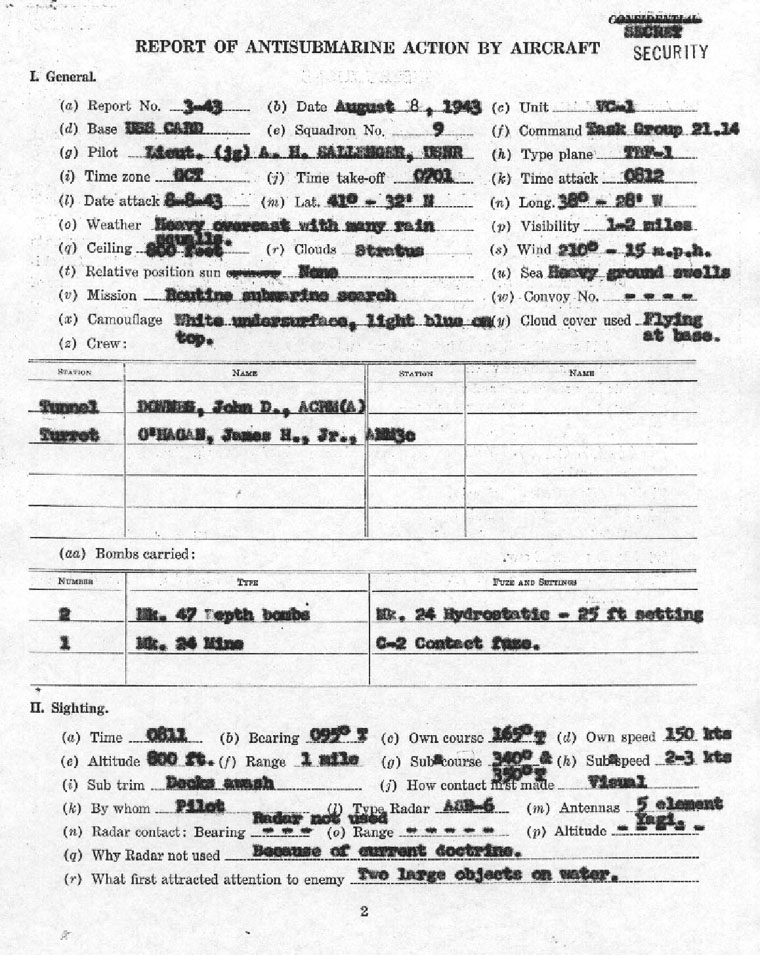
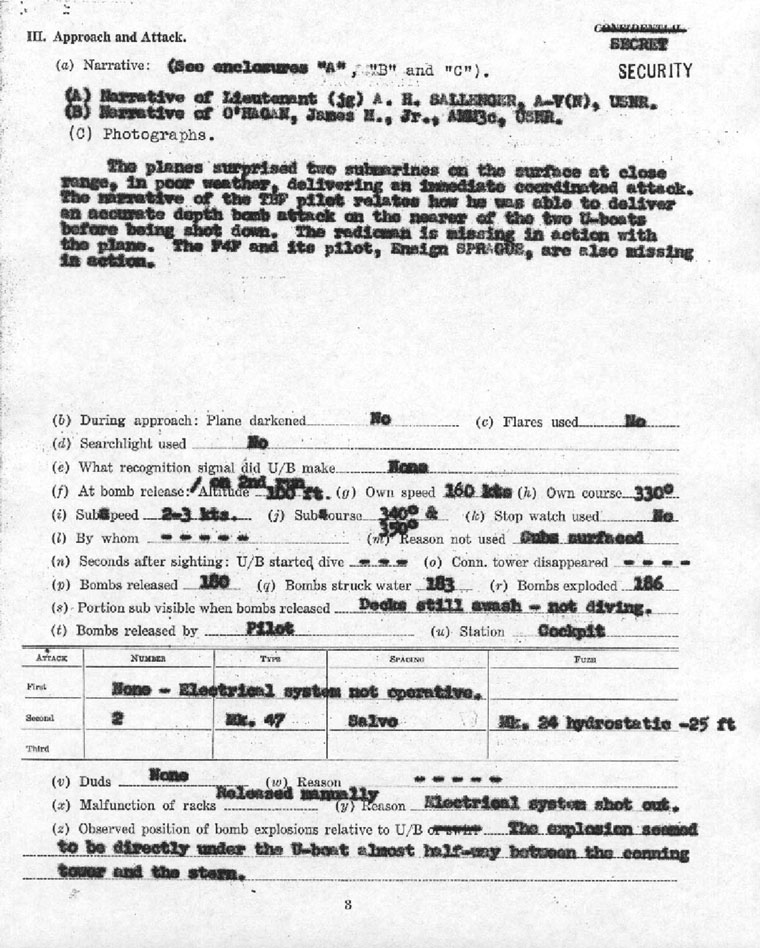
COMPOSITE SQUADRON ONE |
||||
| SECRET | ||||
| August 10, 1943 | ||||
|
||||
STATEMENT OF LIEUTENANT (JG) A. H. SALLENGER, A-V(N), U. S. N. R. |
||||
| I was flying on a routine submarine search in TBF No. 9 in company with Ensign SPRAGUE who was flying F4F-4 No. 16 on my wing. There was a solid overcast with occasional rain squalls and poor visibility, so we were ducking in an d out of the base of the clouds. | ||||
| At about 0811 GCT we came out of a cloud flying at 800 feet and on my port bow, I saw two U-boats not more than 1 or 1-1/2 miles away. They were pretty close together, about 150 yards, and on slightly different courses. The nearest was steering 3400T and the far one 3500T. When sighted, their decks were awash and there was no bow wave or wake visible, indicating a speed of 2-3 knots. My course at the time of sighting was 1650T, speed 150 knots. | ||||
| It all happened so fast that I had no time to advise the ship of the contact before the attack. I had turned on my transmitter to warm it up, figuring on reporting immediately after my first run. I signaled Ensign SPRAGUE to attack. He slid under me and we made a split attack on the nearer of the two subs, coming in from bow to stern, the fighter from the port bow, the TBF from the starboard bow. Ensign SPRAGUE made a beautiful strafing attack, working over the deck and conning tower methodically. When I was a little more than half way in on my attack, range about 1000 yards, my plane was hit by at least one 20mm explosive shell up through the bomb bay into the tunnel compartment. This knocked out my radio, interplane communication, and other electrical equipment. Later I learned that the vertical fin and rudder had also been hit in this barrage. I saw the bomb bay light go out right after the first shell hit. The plane took several more hits in the tunnel and something began to burn in the bomb bay. During this run my speed was about 185 knots, course about 1150T. | ||||
| As a result of the electrical system being out, my bombs did not drop on the first pass. I turned for a second run, coming in this time from the starboard quarter, target angle about 1700. | ||||
- 1 - |
||||
| ENCLOSURE (A) | ||||
COMPOSITE SQUADRON ONE |
||
| SECRET | ||
| August 10, 1943 | ||
STATEMENT OF LIEUTENANT (JG) A. H. SALLENGER, A-V(N), U. S. N. R. CONT'D |
||
| The engine was popping and cutting out during this attack. My speed was reduced to 160 knots, and I was on a course of about 3300. During this run Ensign SPRAGUE was working over the other, unattacked sub. Again he was doing an excellent job, but the enemy AA fire seemed even heavier. On this run, the plane was hit in the left main gas tank at the wing root (It had about 30 gallons in it at the time), tearing a hole about a foot wide and immediately bursting into flames. There were other less effective hits. I proceeded on in and dropped the two depth bombs manually (the bombs, of course, dropped in salvo). I looked back to make sure they exploded, and the explosion seemed to go off right next to the submarine covering it with water. I'm sure it was a good drop. | ||
| By now my wing tank was burning badly, so I jettisoned the Mk. 24 mine, on armed, about 1/2 mile ahead of the course of the U-boat. I then turned directly into the wind (southwesterly 15 mph) and landed in the water with flaps up and bomb bay doors open because the hydraulic system had been punctured, making it inoperative. | ||
| The fire in the wing was put out upon landing. I was unhurt, my gunner, O'HAGAN. popped out of the turret and together we got the rubber boat out. I then realized Chief DOWNES was missing. So, I swam to the other side, dived under and opened the tunnel door. I was half way in the tunnel when the plane started to settle. I estimated it sank within 30 seconds. | ||
| I saw Ensign SPRAGUE going in for another strafing attack while we were inflating the rubber boat. After that, I don't remember seeing the plane or hearing the engine again. | ||
| After hitting the water, we paddled as fast as we could down wind, thinking one of the U-boats might surface near us. Though we did not realize it at the time, this took us right back over the scene of the action. We actually paddled through as large oil slick that must have been left by the attacked submarine as it submerged. It was so new that we could smell the fresh oil. | ||
| Although I did not see the guns on the U-boats, I believe that each had at least six 20mm. The fire came from a platform aft of the conning tower. The U-boats seemed to recognize the TBF as the striking power and concentrated on it till we had been shot down. | ||
- 2 - |
||
| ENCLOSURE (A) | ||
COMPOSITE SQUADRON ONE |
||
| SECRET | ||
| August 10, 1943 | ||
STATEMENT OF LIEUTENANT (JG) A. H. SALLENGER, A-V(N), U. S. N. R. CONT'D |
||
| Ensign SPRAGUE did a wonderful job of strafing and if there was anyone exposed on the decks or conning tower, I know they were hit. This leads me to believe that the guns were either heavily armored or had some kind of remote control. | ||
| It wasn't till I was picked up that I learned Ensign SPRAGUE had probably been shot down and was missing in the action. | ||
| |
||
| A. H. SALLENGER. | ||
- 3 - |
||
| ENCLOSURE (A) | ||
COMPOSITE SQUADRON ONE |
||
| SECRET | ||
| August 10, 1943 | ||
NARRATIVE OF O'HAGEN, James Henry, Jr., 608 27 97, AMM3c, USNR |
||
| It was about 0730 (time zone +0:31) when Mr. SALLENGER saw two submarines on the surface. At this time, they seemed to have spotted us. They looked as though they were going to submerge, so Mr. SALLENGER told me to get ready, that he was going to make his run on them. They opened up fire on us on our first run, hitting the bomb bay, and carrying away the top of the vertical fin and rudder. | ||
| The shells were all around the plane and it was hard to judge where else we were hit. Our electrical system was shot up and I could not work the turret or get in contact with Mr. SALLENGER. A called to DOWNES, our radioman, to ask him to help me turn my turret around as it was stuck. I looked down in the tunnel and he was lying on his face. The radio equipment was on the deck by his feet, the camera by his side smashed up. | ||
| Mr. SALLENGER came in for his second run to drop the depth bombs that could not be released electrically on the first run, and the return fire was heavier than ever. After we dropped the charge, we pulled away, but they again hit the bomb bay tunnel and the port wing gas tank. There was a large hole in the wing, and strips of the turret housing and middle greenhouse cover was blasted off. The wing immediately caught on fire. From this point on until we were about 50 feet off the water, I do not remember anything. When I came to, the plane was burning very fast. Mr. SALLENGER brought it down easily. I got out through the escape hatch in the turret, as Mr. SALLENGER climbed from the cockpit. We got the life raft and I carried it across the wing. Mr. SALLENGER tried to get DOWNES out, but the plane was already under water. | ||
| We inflated the life raft and paddled from the spot where the plane was, so as to get away from the submarines. | ||
| A couple of our planes spotted us in the afternoon after we sent up a liferaft smoke flare. We were picked up an hour later by one of the destroyers and given first aid. | ||
| |
||
| James Henry O'HAGEN, Jr. | ||
| ENCLOSURE (B) | ||
